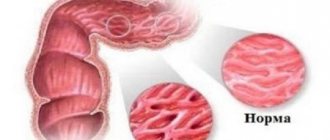What is hyperaldosteronism
Hyperaldosteronism is a fairly frequently diagnosed pathological condition that develops against the background of increased secretion of an adrenal hormone such as aldosterone. The pathology most often occurs in adults, but can also affect children.
- Etiology
- Classification
- Symptoms
- Diagnostics
- Treatment
- Possible complications
- Prevention and prognosis
Provoking factors will differ depending on the form of the disease, ranging from burdened heredity and ending with the course of ailments of an endocrinological or other nature.
Clinical signs for the primary and secondary forms of the disease will be different. The basis of the symptoms are impaired functioning of the heart, muscle weakness, seizures and the development of chronic renal failure.
Only an endocrinologist can make a correct diagnosis and differentiate between the different types of disease, based on data from a wide range of instrumental and laboratory examinations.
Treatment tactics can be either conservative or surgical, which is directly dictated by the type of such pathology. In any case, the lack of therapy is fraught with life-threatening complications.
Diagnosis of the disease
Screening tests are prescribed to accurately determine the diagnosis of hyperaldosteronism. If a patient is taking blood pressure medications, the doctor may suggest taking a break from taking them to see real results. Blood and urine tests confirm aldosterone levels, potassium levels, or renin activity. Computed tomography reveals tumors up to 6-55 mm in size. These analyzes detect adenomas with 95% accuracy. Laboratory data of blood pressure, edema, and plasma aldosterone and renin levels help differentiate primary and secondary aldosteronism.
Causes of hyperaldosteronism
Hyperaldosteronism is a complex of syndromes with different mechanisms of occurrence, but similar symptoms, that develop due to increased secretion of aldosterone.
Since there is primary and secondary hyperaldosteronism, it is natural that the predisposing factors will be somewhat different.
The first type of disease in extremely rare cases occurs against the background of a genetic predisposition. The familial form can be inherited in an autosomal dominant manner - this means that to diagnose such a disease in a child, it is enough for him to inherit the mutant gene from one of the parents.
The defective segment is the enzyme 18-hydroxylase, which for unknown reasons goes beyond the control of the renin-angiotensin system and is corrected by glucocorticoids.
Rare provocateurs of primary hyperaldosteronism include cancer of the adrenal glands.
However, in the vast majority of situations, this variant of the course of the disease is caused by the formation of aldosteroma - this is a neoplasm, which, in fact, is an aldosterone-producing adenoma of the adrenal cortex. Such a tumor is diagnosed in approximately 70% of cases of the primary form of pathology.
Secondary hyperaldosteronism is characterized by the occurrence of another disease in the human body, which means that dysfunction of the endocrine system in such situations acts as a complication.
The following pathological conditions can lead to the development of a secondary type of disease:
- heart failure;
- hypertonic disease;
- cirrhosis of the liver;
- Barter syndrome;
- dysplasia and stenosis of the arteries in the kidneys;
- nephrotic syndrome;
- formation of reninoma in the kidneys;
- renal failure.
In addition, the following can lead to secondary hyperaldosteronism:
- sodium deficiency, which is very often provoked by strict diets or excessive diarrhea;
- a decrease in the volume of circulating blood - this is often observed against the background of heavy blood loss and dehydration;
- excess potassium;
- uncontrolled use of certain medications, in particular diuretics or laxatives.
It is worth noting that the main risk group is female representatives in the age category from 30 to 50 years. However, this does not mean that the disease does not occur in other categories of patients.
Hyperaldosteronism - what is it, symptoms and treatment
Hyperaldosteronism is a pathological syndrome in which excessive production of aldosterone by the zona glomerulosa of the adrenal cortex is diagnosed.
Aldosterone is a mineralocorticosteroid, a hormone responsible for maintaining sodium-potassium balance in the body. Its increased secretion leads to metabolic disorders.
In women, primary hyperaldosteronism is registered 3 times more often, manifestation occurs after 30 years.
Causes
Most often, primary hyperaldosteronism is observed in the following pathological conditions:
- benign and malignant tumors of the adrenal glands (primarily adrenal adenoma);
- hyperplasia of the adrenal cortex.
Secondary hyperaldosteronism develops against the background of:
- excess potassium intake;
- increased sodium loss;
- hypersecretion of renin;
- a sharp decrease in the volume of circulating fluid;
- pregnancy;
- redistribution of extracellular fluid, which leads to a decrease in blood filling of large vessels.
Forms
There are two main forms of the syndrome:
- Primary hyperaldosteronism (excessive production of aldosterone is associated with increased activity of the cellular structures of the zona glomerulosa of the adrenal cortex).
- Secondary hyperaldosteronism (excessive secretion of aldosterone is provoked by disorders in other organs).
Hyperaldosteronism may be associated with dysfunction of the adrenal glands themselves or other organs
Primary hyperaldosteronism, in turn, comes in the following forms:
- idiopathic hyperaldosteronism (IHA) – bilateral diffuse hyperplasia of the zona glomerulosa;
- aldosteroma (aldosterone-producing adenoma, APA, Conn's syndrome);
- primary unilateral adrenal hyperplasia;
- aldosterone-producing carcinoma;
- familial hyperaldosteronism type I (glucocorticoid-suppressed);
- familial hyperaldosteronism type II (glucocorticoid-unsuppressed);
- aldosteronectopic syndrome with extra-adrenal localization of aldosterone-producing tumors (in the ovary, thyroid gland, intestines).
In women, primary hyperaldosteronism is registered 3 times more often, manifestation occurs after 30 years.
There is also pseudoaldosteronism - a condition when the main clinical symptoms of hyperaldosteronism (high blood pressure, hypokalemia) are detected against the background of a decrease in the concentration of aldosterone in the blood plasma.
Signs
Primary hyperaldosteronism is characterized by:
- hypertension (increased blood pressure), accompanied by headaches of varying intensity;
- hypokalemia (clinically manifested by increased fatigue, muscle weakness, cramps);
- lesions of the fundus vessels;
- polyuria (constant feeling of thirst, frequent urge to empty the bladder at night, decreased urine density);
- disorders of the psycho-emotional state (asthenia, hypochondria, anxiety, depression).
High blood pressure is a common symptom of hyperaldosteronism
The most common clinical manifestations of secondary hyperaldosteronism, in addition to the symptoms of the underlying pathology, are:
- increased blood pressure;
- alkalosis;
- decrease in potassium levels in blood plasma.
Features of the course in children
In children, hyperaldosteronism manifests itself in the form of Liddle syndrome, which manifests itself in the first 5 years of a child’s life. It is characterized by:
- severe dehydration;
- increasing hypertension;
- retardation in physical and psycho-emotional development.
Treatment
Therapeutic tactics depend on the form of the disease.
Primary hyperaldosteronism due to aldosteroma or bilateral hyperplasia of the adrenal parenchyma involves surgical correction and restoration of potassium levels in the body by taking potassium supplements and potassium-sparing diuretics.
For the idiopathic form, the following is prescribed:
- angiotensin-converting enzyme inhibitors;
- aldosterone antagonists;
- potassium-sparing diuretics;
- calcium channel blockers.
In children, hyperaldosteronism manifests itself in the form of Liddle syndrome, which manifests itself in the first 5 years of a child’s life
Liddle syndrome is an indication for kidney transplantation.
If the cause of hyperaldosteronism is Liddle's syndrome, kidney transplantation is indicated
Treatment of secondary hyperaldosteronism consists of pathogenetic and symptomatic treatment of the underlying disease.
The criteria for determining the effectiveness of therapy for hyperaldosteronism are:
- normal blood pressure level;
- stabilization of potassium levels in the blood;
- achieving the age-appropriate concentration of aldosterone in the blood.
Prevention
Clinical observation of patients with high blood pressure allows us to identify hyperaldosteronism in the early stages and correct it in a timely manner.
Consequences and complications
An overdose of drugs that block the process of synthesis of adrenal steroid hormones can cause the formation of adrenal insufficiency.
The information is generalized and is provided for informational purposes. At the first signs of illness, consult a doctor. Self-medication is dangerous to health!
Source:
Classification of the disease
Endocrinologists distinguish the following main types of such pathology:
- primary hyperaldosteronism - considered one of the most common variations of the disease;
- secondary hyperaldosteronism - is a complication of diseases that negatively affect the heart, liver and kidneys;
- pseudohyperaldosteronism is a consequence of impaired perception of aldosterone by the distal renal tubules.
At the same time, primary hyperaldosteronism has its own classification, which includes:
- Conn's syndrome;
- idiopathic hyperaldosteronism - develops only against the background of diffuse nodular hyperplasia of the adrenal cortex, which is bilateral. Diagnosed in approximately every third patient who seeks qualified help when symptoms arise;
- unilateral or bilateral adrenal hyperplasia;
- glucocorticoid-dependent hyperaldosteronism;
- aldosterone-producing carcinoma - in total, no more than 100 patients with a similar diagnosis have been registered;
- pseudohyperaldosteronism - is a consequence of impaired perception of aldosterone by the distal renal tubules;
- Itsenko-Cushing syndrome;
- congenital insufficiency of the adrenal cortex or caused by drug overdose.
As a separate form, it is worth highlighting extra-adrenal hyperaldosteronism - it is the most rare. Among the provoking factors, the main place is occupied by diseases of the endocrine system, for example, the ovaries and thyroid gland, as well as the gastrointestinal tract, in particular the intestines.
Symptoms of hyperaldosteronism
As mentioned above, the symptomatic picture will differ depending on the type of disease. Thus, with primary hyperaldosteronism, the expression of the following symptoms is observed:
- increased blood tone - a symptom observed in absolutely all patients, but recently clinicians have noted an asymptomatic course of the disease. Blood pressure is constantly elevated, and this can lead to hypertrophy of the left ventricle of the heart. Against the background of this manifestation, half of the patients experience vascular damage to the fundus, and 20% have a decrease in visual acuity;
- muscle weakness - similar to the previous sign, typical for 100% of patients. In turn, it becomes the cause of decreased performance, the development of a pseudoparalytic state and convulsions;
- change in the shade of urine - it becomes cloudy due to the presence of a large amount of protein in it. Composes the clinical picture for 85% of people;
- an increase in the daily volume of urine excreted – occurs in 72% of patients;
- constant thirst;
- persistent headaches;
- development of asthenic syndrome;
- causeless anxiety.
It is worth considering that the above symptoms refer to the most common form of primary hyperaldosteronism - Conn's syndrome.
Symptoms of secondary type hyperaldosteronism are presented:
- an increase in blood pressure, especially diastolic, which over time leads to the appearance of coronary heart disease, chronic renal failure, kidney dysfunction and damage to the walls of blood vessels;
- neuroretinopathy leading to optic nerve atrophy and complete blindness;
- hemorrhages in the fundus of the eye;
- severe swelling.
Some patients do not show signs of arterial hypertension, and in rare cases, a low-symptomatic course of such a pathology is observed.
In children, hyperaldosteronism often manifests itself before the age of 5 and is expressed in:
- severe manifestation of dehydration;
- increasing arterial hypertension;
- retardation in physical development;
- psycho-emotional disorders.
Forecast
With out-of-date or inadequate treatment, serious complications are possible due to low potassium levels in the blood. Severe cardiac arrhythmias associated with high systolic pressure are sometimes fatal.
During surgical treatment, removal of an adenoma that increases the production of aldosterone, doctors record normalization of blood pressure in 70% of cases.
Arterial hypertension disappears within 4–16 weeks, and blood pressure values gradually return to normal. After 5 years, optimal performance is maintained in half of the cases.
Taking a complex of drugs normalizes potassium levels, prevents cramps, muscle weakness, headaches, and heart rhythm disturbances. Over time, the process of accumulation and excretion of urine is restored.
The prognosis for various forms of pathology is unfavorable due to damage to target organs: kidneys, blood vessels, heart. In this case, surgery to remove the tumor does not produce a noticeable result. The average rate of ineffective therapy does not exceed 5%.
Diagnosis and treatment of all types of hyperaldosteronism is a complex process. It is necessary to find out the exact cause of the deviations, conduct several instrumental studies, and study blood characteristics. With a combination of diet, medication, and surgery, there is a high probability of a positive result of therapy.
Diagnostics
The implementation of a whole range of diagnostic measures is aimed not only at establishing the correct diagnosis, but also at differentiating various forms of the disease in women and men.
First of all, the endocrinologist must:
- get acquainted with the medical history of not only the patient, but also his close relatives - to detect pathologies that may cause secondary hyperaldosteronism or confirm the hereditary nature of the disease;
- collect and study a person’s life history;
- carefully examine the patient - a physical examination is aimed at assessing the condition of the skin and measuring blood pressure. This should also include an ophthalmological examination of the fundus;
- interview the patient in detail - to draw up a complete symptomatic picture of the course of hyperaldosteronism, which can actually indicate the type of its course.
Laboratory diagnosis of hyperaldosteronism involves:
- biochemical blood test;
- general clinical study of urine;
- measuring the daily volume of urine excreted;
- PCR tests – to diagnose the familial form of the disease;
- tests with spironolactone and hypothiazide load;
- "march" test;
- serological tests.
The following instrumental examinations are of greatest value:
- Ultrasound of the adrenal glands, liver and kidneys;
- CT and MRI of the affected organ;
- ECG and EchoCG;
- duplex scanning of arteries;
Duplex scanning of blood vessels
- MSCT and MR angiography;
- scintigraphy.
In addition to the basic diagnosis, the patient should be examined by an ophthalmologist, nephrologist and cardiologist.
Treatment of hyperaldosteronism
The tactics of treating the disease are dictated by its type, however, there are several treatment methods inherent in all forms of hyperaldosteronism. These include:
- maintaining a gentle diet aimed at reducing the consumption of table salt and enriching the menu with foods fortified with potassium;
- taking potassium-sparing diuretics;
- injection of potassium preparations.
Treatment of hyperaldosteronism caused by the formation of aldosteroma or cancer of the adrenal glands is only surgical. The operation involves excision of the affected segment, which first requires restoration of the water and electrolyte balance.
Bilateral hypoplasia of the adrenal cortex is eliminated conservatively. Through the use of ACE inhibitors and calcium channel antagonists.
The hyperplastic form of hyperaldosteronism is treated with complete bilateral adrenalectomy.
For patients with secondary hyperaldosteronism, elimination of the underlying disease and mandatory intake of glucocorticoids are indicated.
Clinical recommendations are individual in nature, as they are completely dictated by the type of hyperaldosteronism.
Classification
Doctors distinguish three types of hyperaldosteronism:
- Primary. The causes of the clinical syndrome are dysfunction of the adrenal glands. Main manifestations: arterial hypertension, low levels of renin and potassium in the blood.
- Secondary. The second name is symptomatic aldosteronism. Negative signs develop against the background of lesions in various parts of the body; excessive production of aldosterone is stimulated. Signs: diastolic pressure increased to 120 mmHg. Art. and more, frequent headaches occur, muscle weakness develops, depression, anxiety, and heart rhythm disturbances appear. Renin level is higher than normal.
- Pseudohyperaldosteronism. The manifestations of the pathology are similar to the course of the classical form; aldosterone levels in the blood plasma are lowered, and not higher than normal. Features: low activity of the hormone renin, alkalosis due to potassium deficiency and arterial hypertension.
Excessive amounts of aldosterone negatively affect the distal parts of the nephron, disrupting the water-electrolyte balance: hydrogen, magnesium and potassium ions are actively removed from the body against the background of sodium retention. The imbalance leads to hypokalemia, hypernatremia, alkalosis, and decreased magnesium levels. Clinical signs of pathology are more active in the primary form of hyperaldosteronism.
Possible complications
Due to the rapid progression of clinical signs, hyperaldosteronism quite often leads to the following complications:
- chronic renal failure;
- migraine;
- complete loss of vision;
- angiosclerosis;
- nephrogenic diabetes insipidus;
- hypertrophy of the left ventricle of the heart;
- cardiac ischemia;
- destruction of the walls of blood vessels;
- paresthesia;
- malignant arterial hypertension.
Prevention and prognosis
To ensure that a man, woman and child does not have problems with the formation of such a disease, it is necessary to adhere to the following general clinical recommendations:
- maintaining a healthy lifestyle;
- proper and nutritious nutrition;
- consultation with geneticists - this is necessary for couples who decide to have children to find out the likelihood of giving birth to a baby with hyperaldosteronism;
- constant clinical observation – indicated for patients with hypertension;
- taking only those medications prescribed by the clinician - with strict adherence to the daily dosage and duration of treatment;
- undergoing a full preventive examination in a medical institution - for early detection of ailments that can lead to the appearance of secondary hyperaldosteronism.
As for the prognosis of the disease, it is dictated by the severity of the underlying disease and the degree of damage to internal organs, as well as timely diagnosis and adequate therapy.
Radical surgical intervention and adequate drug treatment guarantee a complete recovery. The outcome of adrenal cancer is often unfavorable.










